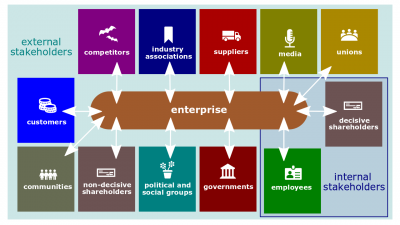Difference between revisions of "Stakeholder"
| Line 6: | Line 6: | ||
According to the [[ INCOSE Systems Engineering Handbook (4th edition)]], | According to the [[ INCOSE Systems Engineering Handbook (4th edition)]], | ||
:[[Stakeholder]]. A party having a right, share, or claim in a system or in its possession of characteristics that meet that party’s needs and expectations. | :[[Stakeholder]]. A party having a right, share, or claim in a system or in its possession of characteristics that meet that party’s needs and expectations. | ||
| + | According to the [[HRBoK Guide]], | ||
| + | :[[Stakeholder]]. An interest holder in an organization. A person, group, or organization that has a direct or indirect interest in the organization (for example, owners, investors, employees, suppliers, unions, or the community). | ||
| Line 15: | Line 17: | ||
*[[Relationship Management Quarter]]. | *[[Relationship Management Quarter]]. | ||
| − | [[Category: Septem Artes Administrativi]][[Category: Articles]][[Category: Business Analysis]][[Category: Systems Engineering]] | + | [[Category: Septem Artes Administrativi]][[Category: Articles]][[Category: Business Analysis]][[Category: Systems Engineering]][[Category: Management]] |
Revision as of 18:58, 21 July 2020
Stakeholder is anyone in the enterprise environment that is, can be, or perceives him-, her-, or itself to be affected by an enterprise's decisions and actions. In Agile methodology, a stakeholder is anyone outside the team who has an interest in the product that the team is producing.
Definitions
According to the BABOK Guide (3rd edition),
- Stakeholder. A group or individual with a relationship to the change, the need, or the solution.
According to the INCOSE Systems Engineering Handbook (4th edition),
- Stakeholder. A party having a right, share, or claim in a system or in its possession of characteristics that meet that party’s needs and expectations.
According to the HRBoK Guide,
- Stakeholder. An interest holder in an organization. A person, group, or organization that has a direct or indirect interest in the organization (for example, owners, investors, employees, suppliers, unions, or the community).
Classification
- External stakeholder. A stakeholder who indirectly contributes and/or may contribute to business and/or management processes of an enterprise, as well as uses its outcomes.
- Internal stakeholder. A stakeholder who directly contributes to business and/or management processes of an enterprise.
